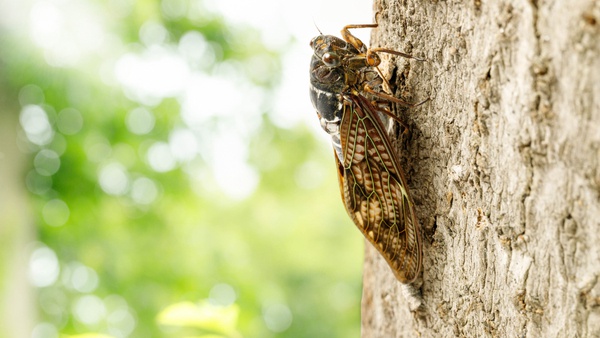It's been 17 years since cicadas last emerged.

Shutterstock photo.
(Lawrenceburg, Ind.) – Cicadas last appeared in the tri-state in 2004.
Seventeen years later, the insects are set to make a return this spring.
According to Purdue University Extension – Entomology, cicadas will appear in mid-to-late May and during June.
The 17-year cicada will begin to emerge approximately when the soil 8” beneath the ground reaches 64 degrees Fahrenheit. Rain typically triggers their emergence.
Most who lived through the last cicada appearance will remember their shrill sounds, but it is only the male cicadas that are responsible for the high-pitched noise. Female cicadas have no sound-producing organs, but they do have a knife-like organ that is used to slit or puncture twigs of woody plants to create a space to lay eggs. The actions of female cicadas cause damage to trees and shrubs.
They commonly lay eggs on oak, hickory, flowering fruit trees, mountain ash, and grape trees. According to Purdue Extension, small ornamental trees and shrubs can be protected by covering them with mesh screening while cicadas are present. Home and land owners are also reminded to avoid planting new trees in the fall before or during the spring cicadas will emerge.
After six weeks, the eggs hatch and the nymphs drop to the ground, dig into the soil, and feed by sucking sap from tree roots.
Depending on the brood, the nymphs will come out of the ground after 13 or 17 years, shed their last shell and emerge as winged cicadas. Adult cicadas live about one month, using the time to mate and lay hundreds of eggs.
This year, tri-state area residents will notice numerous cicadas in areas where trees harbored eggs in 2004.
Cicadas will be present throughout the entire state of Indiana this spring, but will be heaviest in south-central Indiana. Northern Kentucky and southwest Ohio residents will also encounter cicadas.
For more information on what to expect, visit www.extension.entm.purdue.edu.

 Carroll Cropper Bridge Project Will Run Into 2026
Carroll Cropper Bridge Project Will Run Into 2026
 Indiana Republicans Pass Redistricting Bill
Indiana Republicans Pass Redistricting Bill
 DNR: Stay Safe; Always Assume You Are on ‘Thin Ice’
DNR: Stay Safe; Always Assume You Are on ‘Thin Ice’
 St. Elizabeth Facility in Aurora Now Seeing Patients
St. Elizabeth Facility in Aurora Now Seeing Patients
 Lilly Endowment, IDOE Announce Investment to Strengthen Educational Opportunities
Lilly Endowment, IDOE Announce Investment to Strengthen Educational Opportunities
 First Financial Bank Donates $25K to Margaret Mary Health Foundation’s Capital Campaign
First Financial Bank Donates $25K to Margaret Mary Health Foundation’s Capital Campaign












